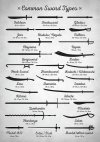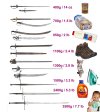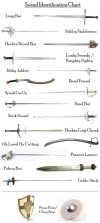If you name me vizier/chancellor/etcetera and let me rule in your stead, I'll grant you excalibur if we find it. Deal?I'll take Excalibur, but I want it with no strings attached.
-
Welcome to the Fantasy Writing Forums. Register Now to join us!
You are using an out of date browser. It may not display this or other websites correctly.
You should upgrade or use an alternative browser.
You should upgrade or use an alternative browser.
Ask me about swords.
- Thread starter Anders Ämting
- Start date
pmmg
 Myth Weaver
Myth Weaver
Excalibur? I got one of those in my basement. I dont need another.
Finchbearer
 Istar
Istar
The strings attached is the Lady of the Lake and she’s pissed.I'll take Excalibur, but I want it with no strings attached.
pmmg
 Myth Weaver
Myth Weaver
Well...she was lobbing Scimitar's about. I thought it was a poor way to determine a system of government, but...who was I to judge.
She can have it back.
She can have it back.
Demesnedenoir
 Myth Weaver
Myth Weaver
All the paparazzi hanging around because I'm too sexy for my sword, too sexy for my sword ::strikes a runway pose:: and all that would still drive me crazy. I'm up for searching lakes, however, so long as you do the swimming. I'll sit on the shore sipping mai-tais, me being the future king and all.
If you name me vizier/chancellor/etcetera and let me rule in your stead, I'll grant you excalibur if we find it. Deal?
Deal. I like swimming anyways. Will put the Excalibur search on my summer scheduleAll the paparazzi hanging around because I'm too sexy for my sword, too sexy for my sword ::strikes a runway pose:: and all that would still drive me crazy. I'm up for searching lakes, however, so long as you do the swimming. I'll sit on the shore sipping mai-tais, me being the future king and all.
Demesnedenoir
 Myth Weaver
Myth Weaver
I'm a bit more feline in my like of water.
Deal. I like swimming anyways. Will put the Excalibur search on my summer schedule
jhmcmullen
 Dreamer
Dreamer
Apologies if someone has already asked this, but I’m looking for a general rule of thumb regarding thrusting versus slashing styles of swords. I have picked up the idea that swords out of the Western European tradition tend to be more thrusting: foil and epee in the modern day, but the swords that in RPGs are called short swords are also thrusting weapons. But there are swords that are more, uh, slash-y. Scimitars, sabres, there was an Egyptian sword I ran across while researching my ancient Egyptian/mongol cross, and so on.
Are there commonalities that lead to the development of more of a cutting sword or a more thrusting sword?
Are there commonalities that lead to the development of more of a cutting sword or a more thrusting sword?
It’s my understanding that purely thrusting swords developed in cities that regulated the size of the weapon you can carry, resulting in their use in duels and then the sport of fencing.
Some of the extra curved slashing swords developed in places where people didn’t use much armor. They could cut through bodies quickly.
There were lots of different sword designs. But most swords used in combat against an equal opponent would’ve been mostly straight and designed for both purposes.
Some of the extra curved slashing swords developed in places where people didn’t use much armor. They could cut through bodies quickly.
There were lots of different sword designs. But most swords used in combat against an equal opponent would’ve been mostly straight and designed for both purposes.
JBCrowson
 Maester
Maester
Cavalry would use slashing swords over thrusting ones as you'd be less likely to get knocked off your horse making a slash as you gallop past than if you impaled your enemy.
pmmg
 Myth Weaver
Myth Weaver
You could not get the longer straight swords, like a rapier, until steel was more common. Its long blade would break if it was iron. Thicker blades could hold up, stab and slash. I suspect you would want both. Curved swords were for horseback, to slide out of cut foes easier. Other swords, like the Khopesh, had an axe like chopping fashion.
Short swords, like the roman glaidus, were made for many purposes, but part of it was, longer swords broke more easily before there was steel.
Really, there are so many styles of sword, it would be hard to be all encompassing.
Short swords, like the roman glaidus, were made for many purposes, but part of it was, longer swords broke more easily before there was steel.
Really, there are so many styles of sword, it would be hard to be all encompassing.
Last edited:
Short swords were popular with soldiers who fought in tight formation with shields, especially if they fought against similarly equipped opponents. When standing side by side with comrades in a shield wall, phalanx or similar, it is much more practical to quickly stab over the top or around a shield than it is to try to wind up for a slash.
People who fought on their own, or who had more room to move could use blades better suited to slashing.
People who fought on their own, or who had more room to move could use blades better suited to slashing.
Mad Swede
 Auror
Auror
OK. Swords intended for slashing tend to have short, curved blades with a very sharp edge on one side. Think in terms of a sabre, cutlass, katana, kukri, machete or falchion. Sword intended for thrusting tend to be short and straight with a sharp point and sharpened edges on both sides. Think in terms of a (European) broadsword, smallsword, shortsword or (Roman) gladius.
Swords for thrusting tend to be used by foot mounted troops because they get into melees, where there usually isn't the time or space to make slashing cuts (although you can do so with these types of swords). These types of swords need more training to be used effectively and so are almost exclusively used as weapons.
Swords and long knives for slashing often have a dual purpose, being used for both fighting and cutting brush, ropes etc (cutlasses, machetes and kukris are prime examples). Swords for slashing are often used by mounted troops, troops who operate in dense vegetation and by sailors. They don't need as much training to use effectively.
Swords for thrusting tend to be used by foot mounted troops because they get into melees, where there usually isn't the time or space to make slashing cuts (although you can do so with these types of swords). These types of swords need more training to be used effectively and so are almost exclusively used as weapons.
Swords and long knives for slashing often have a dual purpose, being used for both fighting and cutting brush, ropes etc (cutlasses, machetes and kukris are prime examples). Swords for slashing are often used by mounted troops, troops who operate in dense vegetation and by sailors. They don't need as much training to use effectively.
I just wanted to clarify, the majority of the swords people have named, except for some of the cavalry weapons, can be used to both cut and thrust, even if they were designed to favor one over the other. You can thrust with a slightly curved weapon like the katana or most sabers. You can cut with a short sword.
Also, mounted cavalry would have multiple weapons, usually including spears or lances which could hit the biggest punch even through armor. Since the spear would handle that thrusting job, swords for mounted cavalry could fill a different role.
Swords in warfare were often a backup weapon. They were light, discrete, and versatile, a good complement to a big polearm.
Also, mounted cavalry would have multiple weapons, usually including spears or lances which could hit the biggest punch even through armor. Since the spear would handle that thrusting job, swords for mounted cavalry could fill a different role.
Swords in warfare were often a backup weapon. They were light, discrete, and versatile, a good complement to a big polearm.
Malik
 Auror
Auror
Slashing does zero against an armored opponent. Stabbing . . . might. Maybe. If you're really good, and they're down on the ground immobile after you've, I dunno, dislocated their shoulder or broken their legs or something.
The short sword, and even the arming sword (~30" blade) were comparable on the battlefield to the modern-day 9mm sidearm. You used a BIG weapon--spear, greatsword, axe, halberd-- to destroy someone's armor, or you used the equivalent of Judo (Google "Abrazare"; it's a 14th-Century wrestling technique for armored knights, and my sparring partner refers to it as "Judo for psychopaths") to break someone inside their armor, at which point you might use a smaller, more precise weapon to stab them through weak or damaged spots.
Slashing weapons were for unarmored opponents. Swords were not lightsabers.
More on this in my article on this site at The Why of Weapons: The Great Sword of War and my blog post on the mechanics of armor at Master Class: Armor | Joseph Malik.
The short sword, and even the arming sword (~30" blade) were comparable on the battlefield to the modern-day 9mm sidearm. You used a BIG weapon--spear, greatsword, axe, halberd-- to destroy someone's armor, or you used the equivalent of Judo (Google "Abrazare"; it's a 14th-Century wrestling technique for armored knights, and my sparring partner refers to it as "Judo for psychopaths") to break someone inside their armor, at which point you might use a smaller, more precise weapon to stab them through weak or damaged spots.
Slashing weapons were for unarmored opponents. Swords were not lightsabers.
More on this in my article on this site at The Why of Weapons: The Great Sword of War and my blog post on the mechanics of armor at Master Class: Armor | Joseph Malik.
Demesnedenoir
 Myth Weaver
Myth Weaver
And then swords got long enough to be a spear, heh heh.
I just wanted to clarify, the majority of the swords people have named, except for some of the cavalry weapons, can be used to both cut and thrust, even if they were designed to favor one over the other. You can thrust with a slightly curved weapon like the katana or most sabers. You can cut with a short sword.
Also, mounted cavalry would have multiple weapons, usually including spears or lances which could hit the biggest punch even through armor. Since the spear would handle that thrusting job, swords for mounted cavalry could fill a different role.
Swords in warfare were often a backup weapon. They were light, discrete, and versatile, a good complement to a big polearm.
Demesnedenoir
 Myth Weaver
Myth Weaver
Chop might actually be a better description for a hit with a sword against armor, trying to shake the sardine in the can, whereas Slash kind of denotes a draw-cut more similar to using a knife and, as seen in so damned many movies, killing an armored opponent. Doh! The Slash is arguably the most devastating blow (not to the head) but also the easiest to defend against with even relatively primitive armor. Enter the Giant Toothpick, heh heh.


Slashing does zero against an armored opponent. Stabbing . . . might. Maybe. If you're really good, and they're down on the ground immobile after you've, I dunno, dislocated their shoulder or broken their legs or something.
The short sword, and even the arming sword (~30" blade) were comparable on the battlefield to the modern-day 9mm sidearm. You used a BIG weapon--spear, greatsword, axe, halberd-- to destroy someone's armor, or you used the equivalent of Judo (Google "Abrazare"; it's a 14th-Century wrestling technique for armored knights, and my sparring partner refers to it as "Judo for psychopaths") to break someone inside their armor, at which point you might use a smaller, more precise weapon to stab them through weak or damaged spots.
Slashing weapons were for unarmored opponents. Swords were not lightsabers.
More on this in my article on this site at The Why of Weapons: The Great Sword of War and my blog post on the mechanics of armor at Master Class: Armor | Joseph Malik.
Did Crusader knights modify their weaponry as they came up against Turk, Arab, and Egyptian foes?
I'm thinking particularly of those who resided in Outremer, more than those who came pounding in during a particular crusade. Those would likely have been equipped as they were back home. But was the lance-based cavalry charge, followed by a dismount and fighting with longsword or flail or mace really a good choice against the armies of Damascus or Cairo or Baghdad?
I know I'm supposedly a medieval historian, but I can't find anything that answers this question. It feels like there ought to have been adjustments because there were resident knights for almost two centuries. Plenty of time to make other choices. Then again, maybe that weaponry, having proved so effective early, continued to be the right choice.
I'm thinking particularly of those who resided in Outremer, more than those who came pounding in during a particular crusade. Those would likely have been equipped as they were back home. But was the lance-based cavalry charge, followed by a dismount and fighting with longsword or flail or mace really a good choice against the armies of Damascus or Cairo or Baghdad?
I know I'm supposedly a medieval historian, but I can't find anything that answers this question. It feels like there ought to have been adjustments because there were resident knights for almost two centuries. Plenty of time to make other choices. Then again, maybe that weaponry, having proved so effective early, continued to be the right choice.
Prince of Spires
 Istar
Istar
The main thing to keep in mind is that making weapons, and especially swords, was expensive. Both in terms of time, skill, and money. Just look up some youtube videos of blacksmiths creating them with modern tools to get an idea of the work involved. They would only go through that effort if the sword actually were worth it.
The biggest factors would be the armor of the opponent, if you're mounted or not, if you're wielding a shield, and the formation you're fighting in.
The biggest factors would be the armor of the opponent, if you're mounted or not, if you're wielding a shield, and the formation you're fighting in.





 Minstrel
Minstrel